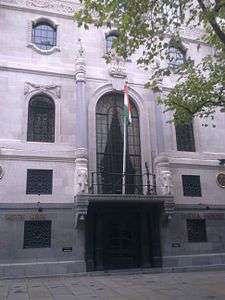India House, London
| High Commission of India in London | |
|---|---|
 | |
| Location | Aldwych, London |
| Address | India House, Aldwych, London, WC2B 4NA |
| High Commissioner | Ruchi Ghanashyam |
The High Commission of India in London is the diplomatic mission of India in the United Kingdom.[1] It is located in India House on Aldwych, between Bush House, what was Marconi House (now Citibank) and the Australia House.[2] It faces both the London School of Economics and King's College London.[3] Since 1981, India House is a Grade II Listed Building.[4]
History
In 1919, a committee chaired by the Marquess of Crewe determined there existed the need to separate the agency work of the India Office from its other political and administrative roles, and recommended the transfer of all such work to "a High Commissioner for India or some similar Indian Governmental Representative in London." It was also felt popular opinion in India would view this as a step towards full Dominion status for India.[5] The Government of India Act that same year upheld the recommendations of the committee, making provision for "the appointment of a High Commissioner by His Majesty by Order in Council, which might delegate to the official any of the contractual powers of the Secretary of State [for India] in Council, and prescribe the conditions under which he should act on behalf of the Government of India or any Provincial Government."
On 13 August 1920, King-Emperor George V issued the required Order in Council. Until India became independent in 1947, the post was styled "High Commissioner for India". The first High Commissioner for India was Indian Civil Service officer Sir William Stevenson Meyer; the first of Indian origin was Sir Dadiba Merwanji Dalal. The High Commissioner enjoyed the same status as his counterparts from the British Dominions.[5] Upon Indian independence, the post was given the present designation.
Proposed in 1925 by the Indian High Commissioner Sir Atul Chatterjee, the building was designed by Sir Herbert Baker and completed in 1930.[3] It was formally inaugurated on 8 July 1930 by the King-Emperor George V.[3] There are twelve decorations on the outside of the building representing the various states of India (under the British Raj), described as follows:
| Emblem | State | Image |
|---|---|---|
| Tiger | Bengal |  |
| Ship | Bombay | .jpg) |
| Fort St George | Madras | .jpg) |
| Fishes and bow and arrow | Central Provinces | |
| Sun and five rivers | Punjab | |
| Bo-tree and swastikas | Bihar and Orissa | .jpg) |
| Snakes | United Provinces | .jpg) |
| Elephant | Delhi |  |
| Rhinoceros | Assam |  |
| Peacock | Burma | .jpg) |
| Camels | Baluchistan |  |
| Moon and gateway | North West Frontier |  |
There is also a bust of Jawaharlal Nehru which was unveiled by John Major in 1991.[3]
Gallery
 The High Commission from India Place
The High Commission from India Place Close-up of some designs
Close-up of some designs Bust of Jawaharlal Nehru on India Place
Bust of Jawaharlal Nehru on India Place
References
- ↑ "The London Diplomatic List" (PDF). 14 December 2013. Archived from the original (PDF) on 11 December 2013.
- ↑ "The London Diplomatic List" (PDF). 14 December 2013. Archived from the original (PDF) on 11 December 2013.
- 1 2 3 4 "India House". 2 November 2013.
- ↑ Historic England. "Details from listed building database (1066491)". National Heritage List for England. Retrieved 28 September 2015.
- 1 2 "Chapter XV- The High Commissioner for India"
- ↑ Mee, Arthur. The King's England London: The Classic Guide (2014 ed.). Amberley. p. 118.
|access-date=requires|url=(help)